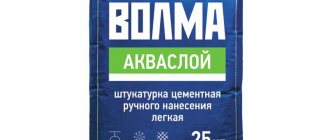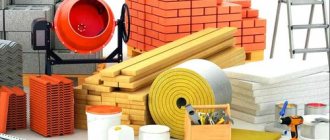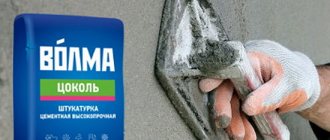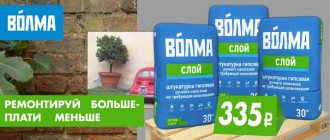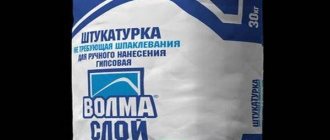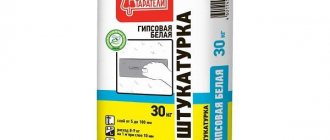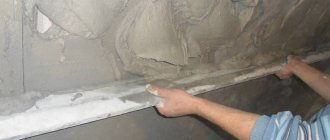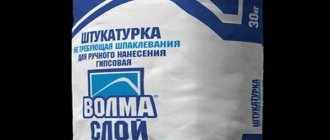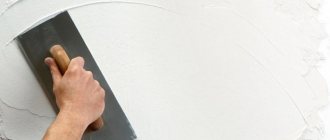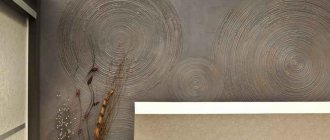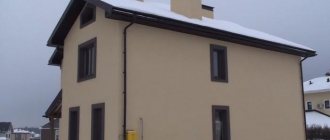Volma Aquaslayer is one of the companies that appeared on the market relatively recently. But the products have already proven themselves only from the best side. Gypsum plaster has become the most common product and is in high demand. It is sold in different packaging, which is especially convenient. Most often used for rooms where there are no differences in temperature and humidity.
Plaster Volma Aquaslayer description
Among the assortment from this manufacturer you can find compounds that help perform any type of work. There are even decorative materials, not to mention finishing, leveling, and plastering materials.
Volma Aqua contains only environmentally friendly products that do not cause any harm to human health. The main share is allocated to substances of mineral origin. But it could not do without binding components and additives, synthetic elements. Some types of plasters can be applied by machine, while others can only be applied by hand.
Volma Aqua contains only environmentally friendly products that do not cause any harm to human health.
Types and scope of application of Volma plaster
The materials have become widely known both among home craftsmen and among those involved in construction as their main profession. There is a wide range of packaging and varieties, so you can always find the right material. Gypsum and cement are the main large groups that can be distinguished in this case.
Volma Aquaslayer is available in different packages, the characteristics do not depend on this:
- 5 kg;
- 15;
- 20;
- 25;
- 30.
There are compositions that require manual or machine application to the surface. The surfaces most often treated with products are floors and ceilings. The operating temperature range is from +5 to +30 degrees. Humidity levels should be kept within 5%.
The differences between different materials are in the purpose and methods of use:
- AquaStandard. It is distributed onto the surface only by machine method. With mineral and synthetic additives, light modified fillers. Good physical properties are achieved through Portland cement. Level walls indoors and outdoors. Can be used even in high humidity;
It is distributed onto the surface only by machine method.
- Layer. To manually plaster walls and ceilings. Layer MH is a machine-applied variety;
To manually plaster walls and ceilings.
- Aquaplast. Mixture with gypsum base. A type of finishing plaster that can be used as a decorative finish. With a long setting period and increased plasticity. Usually its use is organized before laying tiles or gluing wallpaper. Pink and green shades of the mixture are the rarest; most often it is white. The difference between them is almost imperceptible;
With a long setting period and increased plasticity.
- Decor. Changes its shape depending on the application method. To create a decorative layer;
To create a decorative layer.
- Base. Dry mixtures created with cement. Helps eliminate all errors on the foundation and level it. Often used as decorative finishing. It is characterized by increased moisture resistance and strength. There is also an AquaLux option, which is in many ways reminiscent of previous developments.
Helps eliminate all errors on the foundation and level it.
Description and properties of Volma plaster
The company producing dry plaster mixes (hereinafter referred to as SS) - Volma, has existed for more than 70 years. The products were developed by Russian technologists. The line includes a number of plasters with mineral binders, one of which is the Volma gypsum layer. This composition contains more than 90% gypsum.
As in SS from other manufacturers, this mixture contains (in addition to gypsum) additives that increase plasticity, increase setting time, and adhesion. Of course, the SS manufacturers do not disclose the recipe, but they bring the technical characteristics to our attention on the packaging with the Volma brand.
This is information necessary for plasterers when choosing a material. Based on this information, the need for raw materials is calculated, technological maps are drawn up, and walls are plastered.
Gypsum has been used as a binder since ancient times. Essentially, it is a natural stone, deprived of water during the process of dehydration, and ground to increase the contact area. When it encounters water, gypsum is greedily imbued with it, goes into a solution state, and crystallizes, forming an artificial stone.
Plaster solutions with gypsum binder are used when necessary:
- level the surface of the base (rough plaster);
- monolith joints and holes;
- protect building construction materials from external influences (protective cover);
- decorate the interior (decorative function).
Unfortunately, gypsum coatings are less durable than cement-sand coatings. They are also unstable in water, which limits the use of gypsum solutions only to interior work or finishing of glazed loggias.
However, the advantages of gypsum are:
- lightness (low weight gives less load on the base, which is important, for example, for ceilings);
- non-shrinkability (used where the base is weak materials);
- greater plasticity (the absence of sand filler allows the surface to be brought to a high degree of smoothness);
- workability, which allows you to completely successfully fill even narrow gaps;
- the comfort of self-feeling of people in rooms with plaster finishing;
- allowing wall materials to breathe freely;
- high adhesion;
- large coating thickness that does not require reinforcement (Volma guarantees the ability to create a coating layer up to 6 cm thick at a time).
Specifications
You can choose a composition for any application. Including for rooms with varying degrees of humidity. You just need to study in advance the technical characteristics that distinguish this or that composition, including lightness.
You can choose a composition for any application.
Compound
The cement or gypsum base for these plasters is the most common. Plasticizers, stabilizers and modifiers are introduced to improve certain qualities. An example is stickiness, strength, and so on.
The cement or gypsum base for these plasters is the most common.
Colors
The characteristic shades for these mixtures are light yellow, beige and gray. Field of application: leveling various surfaces. White color is most often used when selling finishing materials. It is permissible to use colors in relation to plasters, but such solutions are only suitable for decoration. After drying, the surface is easier to treat with paints, regardless of the composition.
After drying, the surface is easier to treat with paints, regardless of the composition.
Layer thickness
5-30 mm is the recommended thickness in most processing situations. 6 centimeters is the permissible thickness for the plaster layer, but in this case, preliminary reinforcement is required. In the absence of restrictions, the established minimum is 3 millimeters.
5-30 mm is the recommended thickness in most processing situations.
Adhesion (stickiness), strength
A high degree of adhesion in relation to various building materials is characteristic of any compositions from this manufacturer. The compressive strength will be 3.5 MPa. Bending strength - 1.5 MPa.
A high degree of adhesion in relation to various building materials is characteristic of any compositions from this manufacturer.
Frost resistance, moisture absorption
Some plasters can withstand up to 75-100 cycles of defrosting and freezing, which is achieved by the presence of special additives in the composition. Most materials will withstand temperature drops down to -40 degrees without problems. A low degree of water absorption is also relevant in all cases.
Most materials will withstand temperature drops down to -40 degrees without problems.
Technical characteristics of Volma plaster
But let’s not be unfounded and move on to dry numbers. By studying the table below, you can compare the main parameters of putties of a popular brand.
| Type | Variety | Time before setting begins, min. | Final hardening time, days | Allowable layer thickness, mm | Compressive strength, MPa | Consumption, kg of dry mixture per 1 sq. m. |
| Plaster | Plast | 30 | 5 – 7 | 5 – 30 | 2.0 | 10 |
| Layer | 45 | 8 – 9 | ||||
| Cement | Aqualayer | 120 | – | 10 – 30 | 4.0 | 11 – 12 |
| Aqua canvas | 11 | |||||
| Facade | Aquaplast | 120 | – | 10 – 30 | 5.0 | 16 – 18 |
| Base | 10.0 | 14 – 15 | ||||
| Machine applied | Gips-Active | 90 | 5 – 7 | 5 – 30 | 2.0 | 8 – 9 |
| Aquaslayer-MN | 40 – 60 | – | 10 – 15 | 1,5 | 11 – 12 |
Please note that the consumption of VOLMA plaster is indicated when laying in a layer 10 mm thick.
Preparations for work
Optimal environmental conditions are the first condition that needs to be taken care of. Temperatures are expected to range from 5 to 30 degrees above zero. Humidity - up to a maximum of 80%. If these conditions are rejected, the layer will simply collapse and fall off the surfaces. If the walls are frozen, processing them is prohibited. You need to wait some time until the temperature reaches the required levels, otherwise the plaster composition will not give results.
Optimal environmental conditions are the first condition that needs to be taken care of.
Surface preparation
The wall, ceiling or other area that is being treated requires additional preparation. Dirt and various stains, traces of previous finishing must be completely removed. If necessary, use a solvent to clean everything. Parts made of metal are treated with anti-corrosion agents. Some plaster is also needed here.
It is permissible to take other precautions:
- Cleaning walls from traces of mold and mildew. All surfaces are coated with antiseptic. This work is especially important when indoor humidity levels are constantly high. The putty is applied afterwards;
- Getting rid of traces of salt deposits. Washing large depressions with cement mixtures. The cracks need to be widened, and be sure to coat them;
- Applying primer in 1-2 layers. It is better to use a primer from the same company whose compositions are used at the very beginning.
It is better to use a primer from the same company whose compositions are used at the very beginning.
Technology of working with Volma-layer plaster
Experts recommend applying a so-called test layer at the very beginning. Then it will be easier to understand how long it takes for the composition to set. Labor costs and expenses are also determined separately. At this stage, the thickness of the required layer is established, so that later it will be easier. It may differ slightly from analogues.
Experts recommend applying a so-called test layer at the very beginning.
Preparation of the solution
The container is filled with clean water, the standard calculation is 1 kilogram of mixture per 0.28-0.3 liters of water. Then add the dry plaster mixture in the required quantity. The solution is mixed with professional construction mixers, at an average speed of up to 600-800 rpm. You should get a homogeneous plastic mass that has no lumps. For maturation, a technological pause of 3-5 minutes is maintained, then they begin to re-mix so that the cement mortar becomes more effective.
The viability of the mixture is 2 hours if the surrounding temperature reaches 25 degrees. The time can be increased or decreased by lowering or raising the temperature itself. The technical indicator is adjusted without problems.
You should get a homogeneous plastic mass that has no lumps.
Working methods
If all operations are performed correctly, the result will be a smooth surface that meets all requirements. Finishing work can begin just three hours after application.
The plastering work itself involves the following sequence of actions:
- The prepared solution is applied to the surface using a trowel.
- They level with another tool called a “rule”.
- The second layer is applied after the first has completely dried. 40-60 minutes is the standard setting time.
- After 20-30 minutes, the surface is generously moistened with water using a sponge.
- A spatula is used for leveling. How long the material will dry is determined by the operating conditions.
If all operations are performed correctly, the result will be a smooth surface that meets all requirements.
Preparation of the solution
To properly prepare a solution of plaster for the Volma Aquaslayer bathroom, you need to gradually add the contents of the bag to a clean plastic container with water in the ratio of 0.28-0.3 liters of water, preferably at room temperature, per kilogram of dry mixture. Then the combined components are mixed until smooth for 5 minutes and without lump formations. Mixing is done with an electric mixer or a drill with an attachment at low speeds (up to 800). The prepared Volma Aquaslayer bathroom plaster solution must be used up within two hours.
It is necessary to ensure that there is no overdose of water, otherwise this will lead to peeling and cracking.
Advantages
A large number of reviews, both positive and negative, are published about the products of this company. But there are more positive aspects compared to the disadvantages.
The following list can be used as evidence:
- Regulation of the indoor microclimate due to the fact that the surface is breathable;
- The result is a smooth, glossy surface that does not require preliminary puttying;
- Easy to use, even if a light finish is used;
- Reasonable price combined with excellent quality;
- Moisture resistance;
- Low consumption;
- Environmental friendliness;
- High stickiness;
- Frost resistance.
You can create textured surfaces if no further finishing work is carried out.
Regulation of the indoor microclimate due to the fact that the surface is breathable.
Flaws
Users note that sometimes there are mixtures with large fractions. This has a negative effect on subsequent wallpapering. Preliminary priming and heterogeneous mass are also disadvantages. But if necessary, they are easy to handle; for this purpose, a manual application method is used.
Users note that sometimes there are mixtures with large fractions.
An acceptable cost is typical for all formulations produced by this company. 1 kilogram of gypsum mixture, for example, will cost up to 10-15 rubles. 290 rubles is the average cost of one bag weighing up to 30 kilograms. The required amount is easy to calculate in advance, focusing on the approximate consumption. Then the total costs of repairs can be calculated without any problems.
VOLMA-Akvaplast
Description VOLMA-Akvaplast
“VOLMA-Aquaplast” is a dry cement leveling plaster mixture based on Portland cement with light fillers, polymer and mineral additives that improve the performance properties of the solution, crack-resistant, fiber-reinforced, for manual application outside and inside the building.
Specifications
- color
grey
- Layer thickness allowed when sealing shells and potholes on the surface
up to 60 mm
- Recommended layer thickness for walls
10-30 mm
- Maximum particle size
1.25 mm
- Viability of the finished solution in the container
at least 2 hours
- Water consumption per 1 kg of dry mixture, approximately
0.16-0.2 l
- Consumption of dry mixture for a layer thickness of 10 mm
16-18 kg/sq.m
- Compressive Strength
not less than 5.0 MPa
- Strength of adhesion to the base (concrete) at the age of 28 days
not less than 0.4 MPa
- Frost resistance
F35
- Water absorption when saturated with water for 48 hours and samples are completely immersed in water (for outdoor use)
no more than 8%
- Vapor permeability resistance coefficient
0.1-0.15 mg/m h Pa
- Full cycle time
8 ocloc'k
- Operating temperature (for outdoor use)
from - 40ºС to + 60ºС
For manual leveling of walls outside and inside buildings, including in rooms with high relative humidity.
For preparing the surface of walls for tiling: in kitchens, shower rooms, saunas, etc., for applying decorative plasters.
It is not recommended to use for leveling and repairing floors.
- concrete bases, including slag concrete, expanded clay concrete, foam, aerated concrete, - plastered with cement-sand, cement-lime compositions, - masonry made of ceramic and silicate bricks.
The base for plastering must comply with the requirements of SP 71.13330.2017, be dry and durable. The “age” of brickwork must be at least 28 days, and concrete - at least 3 months. The surface must first be cleaned of various types of contaminants and substances that reduce the adhesion of the plaster solution to the base (fats, lubricating oils, bitumen mastics, glue, paint and varnish coatings, etc.). When reconstructing buildings, weak areas of old plaster (delamination from the base, etc.) must be removed from the walls. The prepared base made of ceramic or silicate bricks must be primed with a deep penetration primer. Concrete and other weakly absorbent smooth substrates should be primed with a primer that imparts roughness to the surface. Bases made of foam, aerated concrete and other highly absorbent materials must be primed 2-3 times with a deep penetration primer. The base temperature should not be lower than +5 °C and not higher than + 30 °C.
Pour clean water into the container at the rate of approximately 0.16-0.2 liters per 1 kg of mixture: approximately 4.0-5.0 liters of water per 25 kg bag. Mix the solution with a construction mixer or electric drill with an attachment for 4-5 minutes to achieve a homogeneous plastic mass without lumps, add water or dry mixture if necessary. Maintain a technological pause of 5 minutes for the mortar mixture to “ripen”, then stir again for 1 minute. At +20 °C the mixture remains viable for at least 2 hours. As the temperature decreases, this time increases, and as the temperature rises, it shortens.
Attention: Avoid overdosing on water, as excess water leads to peeling and loss of mechanical strength of the plaster, as well as the appearance of cracks on the surface.
Application of mortar mixture:
Spread the finished solution evenly onto the prepared base using a trowel, trowel, plaster ladle, or apply with a plaster trowel. Level using an h-shaped rule until a smooth surface is obtained. Check vertical deviations with a two-meter building level, not allowing deviations of more than 5 mm. After the time has passed, when the solution begins to set (approximately 4-8 hours), the surface must be moistened and rubbed with a felt or polyurethane grater. When using the latter, the surface becomes rougher.
Conditions for performing work:
The applied material cannot be dried by force: using heaters, heat guns and other devices.
When working on facades, freshly laid plaster should be protected from precipitation for three days, as well as from excessive drying and cooling. Do not begin finishing work in rain or strong winds.
Bags with dry mixture “VOLMA-Aquaplast” should be stored on wooden pallets in dry rooms. Guaranteed shelf life (shelf life) in undamaged original packaging is 12 months.
Carry out work in accordance with construction requirements, standards and occupational safety and health regulations.
All stated quality indicators and recommendations are valid for an ambient temperature of +20°C and a relative air humidity of 60%. In other conditions, the technical characteristics of the material may differ from those indicated.
Types of Volma plaster
The composition and quality of dry mixtures are of decisive importance; when purchasing them, you should decide in advance which characteristics are important and which can be neglected. Since it is impossible to predict in advance what difficulties may arise during construction or renovation, it is advisable to stock up on materials for different purposes.
Gypsum plasters
Judging by the reviews left online, regardless of the specific version, VOLMA gypsum plaster attracts consumers:
- Plasticity. It is important for finishing work of any complexity, allowing you to quickly level surfaces without making significant efforts and without wasting extra time.
- Homogeneity of structure. By following the instructions, you can prepare a solution that contains no lumps or foreign inclusions.
- Economical consumption. In order to cover a 10 mm thick layer of walls or ceilings over an area of 1 sq. meter, 8 - 9 kg of dry mixture is required.
But the viability time leaves much to be desired. The VOLMA-Plast plaster and its closest analogue, VOLMA-Layer, set quickly, which forces the solution to be prepared in small portions.
Average price from VOLMA-Sloy from 322 rubles per 30 kg
Volma Aquaslayer cement mixtures
It is necessary to use heavy cement that is difficult to process instead of a light and plastic gypsum base in cases where strength is more important than the quality of the plastered surfaces. In this product category, the dry mix “VOLMA-Aquaslayer” is popular, attracting buyers:
- Durability.
- Long viability of the finished solution.
- Low level of moisture absorption.
The latter is important for those cases when the material is used for outdoor work. However, remembering the advantages, we should not forget about the disadvantages, the main of which are:
- Reducing the maximum permissible layer thickness.
- Increased material consumption.
The increased consumption of cement-based VOLMA plaster is especially noticeable when compared with gypsum mixtures.
Facade plasters Volma Sokol
Operated in difficult conditions, building facades are constantly exposed to mechanical and temperature influences. For their finishing it is necessary to use materials with appropriate characteristics. For example, the dry mixture “VOLMA-Tsokol”, optimized for facade work. Among its advantages:
- Strength.
- Frost resistance.
- Low level of moisture absorption.
However, if you are going to use this material, you need to be prepared for an increase in its consumption and cost.
Mixtures intended for machine application
VOLMA-Gips-Active plaster has earned recognition from professionals. The solution, recommended for application using various means of mechanization, has a long viability. However, it cannot be used to seal serious surface defects due to limitations in layer thickness.
